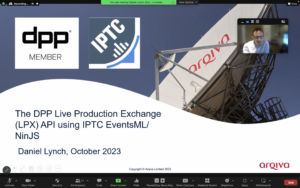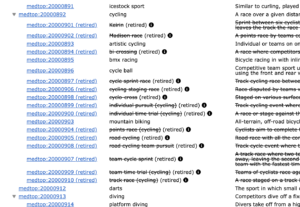Categories
Archives
The IPTC NewsML-G2 Working Group and the News Architecture Working Group are happy to announce the release of the latest version of our flagship XML-based news syndication standard: NewsML-G2 v2.33.
Changes in the latest version are small but significant. We have added support for the Digital Source Type property which is already being used in IPTC’s sister standards IPTC Photo Metadata Standard and IPTC Video Metadata Hub and ninjs. This property can be used to declare when content has been created or modified by software, including by Generative AI engines.
Examples of other possible values for the digital source type property using the recommended IPTC Digital Source Type NewsCodes vocabulary are:
| ID (in QCode format) | Name | Example |
| digsrctype:digitalCapture | Original digital capture sampled from real life:
The digital media is captured from a real-life source using a digital camera or digital recording device |
Digital video taken using a digital film, video or smartphone camera |
| digsrctype:negativeFilm | Digitised from a negative on film:
The digital image was digitised from a negative on film on any other transparent medium |
Digital photo scanned from a photographic negative |
| digsrctype:minorHumanEdits | Original media with minor human edits:
Minor augmentation or correction by a human, such as a digitally-retouched photo used in a magazine |
Original audio with minor edits (e.g. to eliminate breaks) |
| digsrctype:algorithmicallyEnhanced | Algorithmic enhancement: Minor augmentation or correction by algorithm |
A photo that has been digitally enhanced using a mechanism such as Google Photos’ “denoise” feature |
| digsrctype:dataDrivenMedia | Data-driven media: Digital media representation of data via human programming or creativity |
Textual weather report generated by code using readings from weather detection instruments |
| digsrctype:trainedAlgorithmicMedia | Trained algorithmic media: Digital media created algorithmically using a model derived from sampled content |
A “deepfake” video using a combination of a real actor and a trained model
|
The above list is a subset of the full list of recommended values. See the full IPTC Digital Source Type NewsCodes vocabulary for the complete list.
Guidance on using Digital Source Type
The IPTC Photo Metadata User Guide contains a section on Guidance for using Digital Source Type including examples for various types of media, including images, video, audio and text. The examples referenced in this guide can also apply to NewsML-G2 content.
Where Digital Source Type can be used in NewsML-G2 documents
The new <digitalSourceType> property can be added to the contentMeta section of any G2 NewsItem, PackageItem, KnowledgeItem, ConceptItem or PlanningItem to describe the digital source type of an item in its entirety.
It can also be used in the partMeta section of any G2 NewsItem, PackageItem or KnowledgeItem to describe the digital source type of a part of the item. In this way, content such as a video that includes some captured shots and AI-generated shots can be fully described using NewsML-G2.
Find out more about NewsML-G2 v2.33
All information related to NewsML-G2 2.33 is at https://iptc.org/std/NewsML-G2/2.33/.
The NewsML-G2 Specification document has been updated to cover the new version 2.33.
Example instance documents are at https://iptc.org/std/NewsML-G2/2.33/examples/.
Full XML Schema documentation is located at https://iptc.org/std/NewsML-G2/2.33/specification/XML-Schema-Doc-Power/
XML source documents and unit tests are hosted in the public NewsML-G2 GitHub repository.
The NewsML-G2 Generator tool has also been updated to produce NewsML-G2 2.33 files using the version 38 catalog.
For any questions or comments, please contact us via the IPTC Contact Us form or post to the iptc-newsml-g2@groups.io mailing list. IPTC members can ask questions at the weekly IPTC News Architecture Working Group meetings.

Many image rights owners noticed that their assets were being used as training data for generative AI image creators, and asked the IPTC for a way to express that such use is prohibited. The new version 2023.1 of the IPTC Photo Metadata Standard now provides means to do this: a field named “Data Mining” and a standardised list of values, adopted from the PLUS Coalition. These values can show that data mining is prohibited or allowed either in general, for AI or Machine Learning purposes or for generative AI/ML purposes. The standard was approved by IPTC members on 4th October 2023 and the specifications are now publicly available.
Because these data fields, like all IPTC Photo Metadata, are embedded in the file itself, the information will be retained even after an image is moved from one place to another, for example by syndicating an image or moving an image through a Digital Asset Management system or Content Management System used to publish a website. (Of course, this requires that the embedded metadata is not stripped out by such tools.)
Created in a close collaboration with PLUS Coalition, the publication of the new properties comes after the conclusion of a public draft review period earlier this year. The properties are defined as part of the PLUS schema and incorporated into the IPTC Photo Metadata Standard in the same way that other properties such as Copyright Owner have been specified.
The new properties are now finalised and published. Specifically, the new properties are as follows:
- Data Mining: a field with a value from a controlled value vocabulary. Values come from the PLUS Data Mining vocabulary, reproduced here:
- http://ns.useplus.org/ldf/vocab/DMI-UNSPECIFIED (Unspecified – no prohibition defined)
- http://ns.useplus.org/ldf/vocab/DMI-ALLOWED (Allowed)
- http://ns.useplus.org/ldf/vocab/DMI-PROHIBITED-AIMLTRAINING (Prohibited for AI/ML training)
- http://ns.useplus.org/ldf/vocab/DMI-PROHIBITED-GENAIMLTRAINING (Prohibited for Generative AI/ML training)
- http://ns.useplus.org/ldf/vocab/DMI-PROHIBITED-EXCEPTSEARCHENGINEINDEXING (Prohibited except for search engine indexing)
- http://ns.useplus.org/ldf/vocab/DMI-PROHIBITED (Prohibited)
- http://ns.useplus.org/ldf/vocab/DMI-PROHIBITED-SEECONSTRAINT (Prohibited, see Other Constraints property)
- http://ns.useplus.org/ldf/vocab/DMI-PROHIBITED-SEEEMBEDDEDRIGHTSEXPR (Prohibited, see Embedded Encoded Rights Expression property)
- http://ns.useplus.org/ldf/vocab/DMI-PROHIBITED-SEELINKEDRIGHTSEXPR (Prohibited, see Linked Encoded Rights Expression property)
- Other Constraints: Also defined in the PLUS specification, this text property is to be used when the Data Mining property has the value “http://ns.useplus.org/ldf/vocab/DMI-PROHIBITED-SEECONSTRAINT“. It can specify, in a human-readable form, what other constraints may need to be followed to allow Data Mining, such as “Generative AI training is only allowed for academic purposes” etc.
The IPTC and PLUS Consortium wish to draw users attention to the following notice included in the specification:
Regional laws applying to an asset may prohibit, constrain, or allow data mining for certain purposes (such as search indexing or research), and may overrule the value selected for this property. Similarly, the absence of a prohibition does not indicate that the asset owner grants permission for data mining or any other use of an asset.
The prohibition “Prohibited except for search engine indexing” only permits data mining by search engines available to the public to identify the URL for an asset and its associated data (for the purpose of assisting the public in navigating to the URL for the asset), and prohibits all other uses, such as AI/ML training.
The IPTC encourages all photo metadata software vendors to incorporate the new properties into their tools as soon as possible, to support the needs of the photo industry.
ExifTool, the command-line tool for accessing and manipulating metadata in image files, already supports the new properties. Support was added in the ExifTool version 12.67 release, which is available for download on exiftool.org.
The new version of the specification can be accessed at https://www.iptc.org/std/photometadata/specification/IPTC-PhotoMetadata or from the navigation menu on iptc.org. The IPTC Get Photo Metadata tool and IPTC Photo Metadata Reference images been updated to use the new properties.
The IPTC and PLUS Coalition wish to thank many IPTC and PLUS member organisations and others who took part in the consultation process around these changes. For further information, please contact IPTC using the Contact Us form.

Last week the IPTC held another very successful member meeting. The 2023 IPTC Autumn Meeting, held virtually this time, had well over 50 attendees from over 30 organisations in at least 15 different countries.
Highlights included Standards Committee approval of a brand new standard, IPTC Sport Schema v1.0, plus the approval of three new versions of existing standards: NewsML-G2 v2.33, IPTC Photo Metadata Standard 2023.1, and Video Metadata Hub v1.5. We will be publishing more information about each of these updates over the coming weeks.
We also heard from two real-world projects in the broadcast industry. One has just completed and the other is still in its planning stages, but both are based on IPTC standards. The ASBU Cloud system was presented by IPTC member Broadcast Solutions, and the DPP Live Production Exchange was presented by new IPTC member Arqiva.
We also heard guest presentation from Will Kreth of the HAND talent identity platform, the latest on C2PA and Project Origin, had a demo of IPTC Sport Schema using MarkLogic from Progress Software (also an IPTC member).
All Working Groups presented their recent work, which included interesting discussions about proposed new NewsCodes vocabularies and how to address the needs of Artificial Intelligence across all of our standards, work that has been going on for years but now acquires a new urgency.
At the IPTC Annual General Meeting 2023, we voted in the existing Board of Directors for another term and and heard updates about all the great work that has taken place at IPTC this year.
It was a great event and we are already looking forward to the next member meeting, to be held in person in New York in April 2024!

The IPTC News Codes Working Group has just released a new batch of changes to the IPTC NewsCodes family of controlled vocabularies.
Note that we skipped the Q2 update this year because there weren’t many changes, and also because there were already so many changes in Q1 of this year.
Media Topic changes
Here’s a summary of changes to Media Topic vocabulary:
- 2 new concepts: sustainability, profit sharing
- 3 retired concepts: justice, restructuring and recapitalisation, soft commodity
- 7 modified names (labels): restructuring and recapitalisation, soft commodity, study of law, sport shooting, sport organisation, recreational hiking and climbing, mountaineering, disabilities (German and Norwegian translations)
- 2 modified definitions: mountaineering, sport organisation
Change to Media Topic tree browser
We have made a small change to the Media Topic tree browser tool: we now display a small “i” icon next to the label name for terms that have notes defined.
The terms that have notes are usually retired terms, and the note gives the user information regarding which terms should be used instead of the retired term. But in other cases notes are used to help explain changes or clarify usage.
Changes to other vocabularies
Other vocabularies have also been updated:
- Content Production Party Role sees two new terms, contentEditor and metadataEditor, that can be used to show changes made by humans or systems (such as AI engines)
- Format had a small change to indicate that it is not just for NewsML 1 documents.
- User Action Type had a small bug fix, changed references to Twitter / X and retired Google Plus as a term. More changes will be coming soon covering other social media platforms and ways to track user interactions with media content.
- The rendition CV has been updated to make it more generic – renditions can apply to any type of media, not just images and video.
- The digitalsourcetype CV had already been updated in July to handle inpainting and outpainting but we mention it again here as a reminder.
Thanks to the representatives from IPTC members AFP, NTB, Bonnier News, ABC Australia, Bloomberg, New York Times and Associated Press for their contributions to the changes this quarter via the NewsCodes Working Group.
We are still working on our regular review of Media Topics – currently we are in the middle of a review of the Economy branch. The review is not yet complete but we hope for it to be ready for the Q4 or Q1 update.